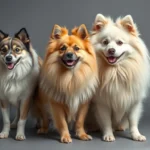
Introduction
Dog breeds play a significant role in the lives of pet owners, each offering unique traits and characteristics that appeal to different individuals and families. In recent years, designer breeds have gained popularity, with the Jackaranian standing out as a fascinating example. This hybrid breed is a mix between the lively Jack Russell Terrier and the affectionate Pomeranian, combining the best traits of both parent breeds.
With the growing trend towards mixed breeds in contemporary pet ownership, the Jackaranian has captured the hearts of many dog lovers. This article delves into the intricacies of the Jackaranian, exploring its characteristics, care needs, and overall suitability as a pet.
Understanding the Jackaranian
What is a Jackaranian?
The Jackaranian is a designer dog breed that results from crossing the Jack Russell Terrier with the Pomeranian. This crossbreed emerged in the late 20th century, as breeders began to explore the idea of combining traits from different breeds to create unique pets. With its origins rooted in two highly energetic and intelligent breeds, the Jackaranian has quickly gained a reputation for its vibrant personality and charming appearance.
Physical Characteristics
The Jackaranian is a small-sized dog, typically weighing between 10 to 15 pounds. They stand about 8 to 12 inches tall at the shoulder, making them a perfect companion for those who prefer a pint-sized pooch. Their coats can vary, often showcasing a mix of the Pomeranian’s fluffy fur and the Jack Russell’s short hair. Common coat colors include white, black, tan, and a combination of these shades.
Distinctive features of the Jackaranian include their large, expressive eyes and ears that can either stand upright or flop down, depending on the individual dog. Their tails are usually curled over their backs, adding to their adorable appearance.
Temperament and Behavior
The Jackaranian is known for its energetic, friendly, and alert temperament. These dogs inherit the playfulness of the Jack Russell Terrier, coupled with the affectionate nature of the Pomeranian. They are often described as intelligent and eager to please, making them relatively easy to train.
Their lively disposition makes them well-suited for family life, and they adapt well to various living situations, whether in a bustling home with children or a quieter environment with seniors. However, it is important to note that their high energy levels mean they require plenty of playtime and mental stimulation.
Health Considerations
Common Health Issues
Like any breed, the Jackaranian may be prone to certain health issues. Some common concerns include dental problems, patellar luxation (a knee joint issue), and eye conditions such as cataracts. These potential health problems are often inherited from their parent breeds, so prospective owners should be aware of these risks.
Regular Health Checks and Preventative Care
Routine veterinary visits are essential for maintaining the health of a Jackaranian. Regular check-ups help in identifying any health issues early on, allowing for prompt treatment. Vaccinations and preventative treatments, such as flea and tick prevention, are also crucial for keeping your pet healthy.
Lifespan
The average lifespan of a Jackaranian is around 12 to 15 years. Factors influencing longevity include genetics, diet, exercise, and overall care. Providing a healthy lifestyle can contribute to a longer, happier life for your furry friend.
Care Requirements
Nutrition
A well-balanced diet is essential for the health and well-being of a Jackaranian. High-quality dog food that meets their nutritional needs should be the foundation of their diet. Portion control is important, as these small dogs can be prone to obesity. Consulting with a veterinarian can help you determine the best diet for your Jackaranian, taking into account their age, weight, and activity level.
Exercise Needs
The Jackaranian has a high energy level and requires regular exercise to stay healthy and happy. Daily walks, playtime in the yard, or interactive games are excellent ways to meet their exercise needs. Aim for at least 30 minutes of physical activity each day to ensure they remain stimulated and engaged.
Grooming
Grooming needs for a Jackaranian can vary based on their coat type. If they inherit the fluffy coat of the Pomeranian, more frequent grooming may be necessary to prevent matting and tangles. Generally, brushing once or twice a week and regular baths will keep their coat clean and healthy. Additionally, regular dental care is essential, as small breeds are prone to dental issues.
Training and Socialization
Early training and socialization are crucial for a well-adjusted Jackaranian. They are intelligent dogs that respond well to positive reinforcement techniques. Start with basic commands and gradually introduce more advanced training as they progress. Socializing your Jackaranian with other dogs and people helps them develop into a confident and well-mannered companion.
Living with a Jackaranian
Ideal Living Conditions
The Jackaranian is versatile in terms of living conditions. They adapt well to apartment living, provided they receive enough exercise and mental stimulation. However, they also thrive in homes with yards where they can play freely. This breed is compatible with families, singles, and seniors alike, making them a great choice for various lifestyles.
Interaction with Other Pets
Generally, Jackaranians tend to get along well with other dogs and pets, especially if they are socialized from a young age. When introducing a Jackaranian to existing pets, it’s important to supervise their interactions and provide a safe environment for everyone involved.
Travel Considerations
Traveling with a Jackaranian can be a delightful experience, thanks to their small size and adaptable nature. When preparing for travel, ensure that you have a comfortable carrier or travel crate, and consider their needs throughout the journey. Regular breaks for potty and exercise will keep them happy during longer trips.
Pros and Cons of Owning a Jackaranian
Advantages
Owning a Jackaranian comes with numerous benefits. These dogs are known for their companionship and loyalty. Their low-shedding coats make them a suitable option for those with allergies. Additionally, their playful nature and intelligence make them fun and engaging pets that can easily become beloved family members.
Disadvantages
However, potential owners should also consider some challenges associated with the Jackaranian. They can be somewhat stubborn, making training more demanding for inexperienced owners. Additionally, their high energy levels require a commitment to regular exercise and mental stimulation, which may not suit everyone’s lifestyle.
Conclusion
The Jackaranian is a captivating breed that combines the best traits of the Jack Russell Terrier and the Pomeranian. With their vibrant personality, adaptability, and affectionate nature, they can make wonderful companions for a variety of households. However, prospective owners should carefully consider their lifestyle and the care requirements of this lively breed.
Thorough research and reflection on one’s ability to meet the needs of a Jackaranian will help ensure a fulfilling relationship with this charming dog. If you believe you can provide the attention, care, and love that a Jackaranian deserves, you may just find your next furry best friend.
FAQ
Common Questions about the Jackaranian
What is the average cost of a Jackaranian?
The cost of a Jackaranian can vary widely, typically ranging from $300 to $1,000, depending on the breeder and location.
Are Jackaranians hypoallergenic?
While Jackaranians may produce less dander than some breeds, they are not considered hypoallergenic. Regular grooming can help minimize allergens.
How do I train a Jackaranian to be housebroken?
Consistent and positive reinforcement techniques work best for housebreaking a Jackaranian. Take them outside frequently, especially after meals, and reward them for doing their business outdoors.
What is the best way to socialize a Jackaranian with other dogs?
Start socializing your Jackaranian early by introducing them to other dogs in safe environments. Positive experiences during these introductions will help them grow into a well-adjusted adult dog.









